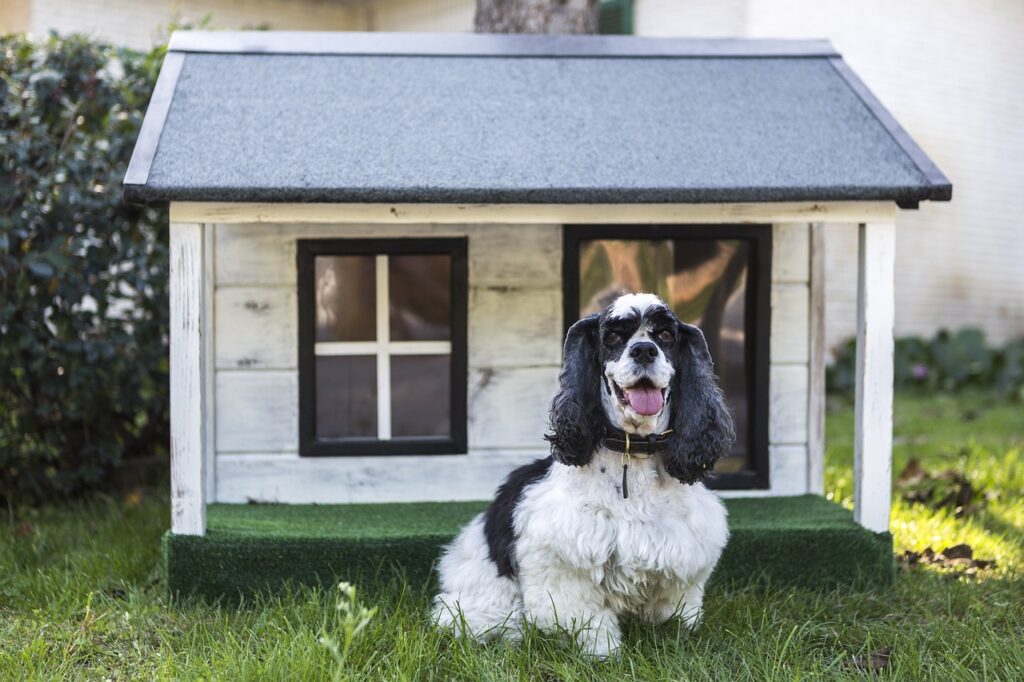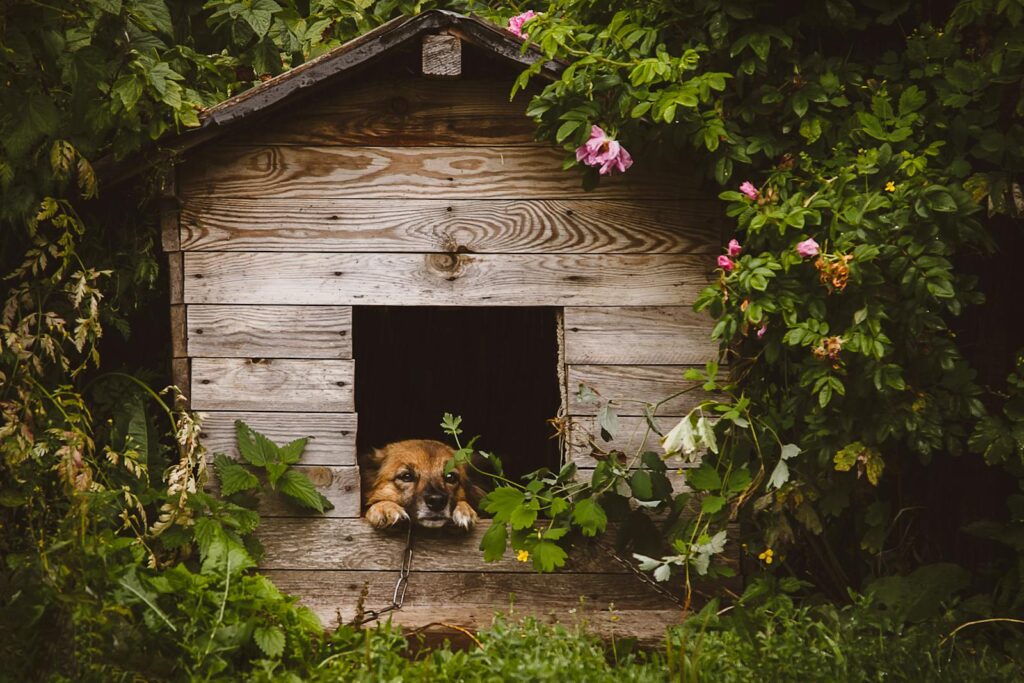Building a snug little dog house is more than just a crafty weekend project – it’s a way to show your furry friend they’re truly part of the family. Not only does a properly constructed abode give your dog refuge from the hot sun and harsh weather, but it can also be a safety sanctuary and a comfortable haven. Here’s how you can create a durable and cozy space for your pet that’s built to last and can even complement the look of your home!
Before we dive into hammering and sawing, let’s start with the basics: planning and design. Every good project kicks off with understanding the needs of your end user—in this case, your dog. You’ll want to tailor the size of the dog house to fit your pet, keeping in mind not just their current size but their full-grown dimensions if they’re still a pup. And because you want this retreat to stand the test of time, choosing suitable materials and considering weatherproofing techniques is key. From the walls to the roof, ventilation to insulation, we’ll explore how to make a comfortable, cost-effective dog house that also makes a statement in your backyard.
Planning and Designing Your Dog House
So, you’ve decided to build a cozy retreat for your furry best friend. Before you start hammering away, let’s talk planning and design. A well-thought-out dog house not only ensures comfort for your pet but also minimizes waste and cost. A good design is about smart use of materials, ensuring the dog house is durable, and can stand up against the elements, which means less headache for you in the long run. Let’s make sure it’s done right from the ground up!
As you envision the perfect shelter, consider the size of your pup—big dogs need room to lounge, and small dogs appreciate a snug fit. Your material choice will affect durability, insulation, and the overall look of the dog house. Will it have a traditional sloped roof or a modern flat top? How about ventilation to keep it fresh in the summer and insulation for those chilly nights? Okay, let’s dive into the details.

Sizing the Dog House to Fit Your Pet
The size is super important—it’s gotta be just right for your dog. Think Goldilocks: not too big, not too small. For a roomy feel with no wasted space, the house should be a bit taller than your dog when standing and just a bit longer than your canine friend from nose to tail. Dogs feel secure in spaces that are snug, but still allow them to move around comfortably.
Here’s a tip: the dog house’s length should be about 6 inches to a foot longer than your pooch, and the height should match the length. Make the width about 6 inches narrower than the length. Now, that’s a blueprint for a cozy doggie den!
Choosing Suitable Materials for Construction
When it comes to selecting your materials, plywood has our vote. It’s not just affordable, it also reduces waste since you can create a sturdy structure with just one piece! Plus, the essentials like screws, and 2x2s and 2x4s for framing are straightforward and won’t break the bank. With these materials, you’re on your way to a rock-solid yet inexpensive build!
Remember to grab some quality screws—1 1/4″ exterior deck screws and 8 x 3″ screws, to be exact. They’re the backbone of keeping everything together. Pre-drill the holes to dodge any splitting headaches and get ready to put it all together.
Deciding on the Type of Roof: Flat or Sloped
The roof style is more than just looks—it’s about functionality too. A flat roof can double as a lounge spot for your pup on sunny days, while a sloped roof will slough off rain and snow like a champ. Whatever you choose, be sure to include an overhang to shield the entrance from the elements.
If you’re leaning towards a sloped roof, grab your calculator, because it’s time to use the Pythagorean theorem to figure out the correct lengths. This ensures your dog house isn’t just stylish, but structurally sound too. After all, more than treats, a roof over their head is what’s truly important.
Considering Ventilation, Insulation, and Weatherproofing
Keep your buddy breathing easy with good ventilation. Just a couple of strategically placed vents can keep that air moving. For colder climates, think insulation—nothing too fancy, even straw bedding will do. But if you’re going full DIY champion, line those walls with rigid foam and cover it to keep your dog warm and toasty.
Weatherproofing is your final defense against Mother Nature. Seal edges and use wood filler on plywood to make it last through the rain showers and snowstorms. And if you’re painting, let it dry before letting your dog give it the sniff test.
| Design Element | Consideration |
|---|---|
| Size | Big enough for comfort, small enough for warmth |
| Materials | Plywood, 2x4s, 2x2s, screws |
| Roof | Choose flat for lounging or sloped for weather protection |
| Ventilation & Insulation | Essential for airflow and temperature control |
Gathering Materials and Tools
Before we dive into building your best friend’s new home, it’s essential to have all your materials and tools lined up. That perfect dog house won’t build itself, right? But with the right stuff at hand, it’ll come together like a charm. We’re aiming for a design that’s not only space-efficient (hello, one piece of plywood with minimal waste!) but also durable and comfy for canines of all sizes. Whether you have a gentle giant or a petite pooch, the goal is a dog house that stands the test of time without emptying your wallet. From sturdy legs to screw those panels tight, let’s make sure you’re good to go!
First things first, you’ll need 3/4″ plywood for the main structure—just one single piece to keep it cost-effective and material-efficient. Then, gather your 2x4s for the legs and door frame, and 2x2s for lining the interior. Our screw collection will mainly consist of a box of 1 1/4″ exterior deck screws for assembly, with some extra 8 x 3″ ones for the door frame lining. And remember, a loose-fitting bottom piece makes for easier cleaning, and proper pre-drilling avoids wood splits when securing the frame.
List of Necessary Building Materials
| Material | Quantity | Use |
|---|---|---|
| 1/2″ Plywood | 1 piece | Main structure |
| 2×4 lumber (30″ pieces) | 4 | Legs |
| 2×4 lumber (varied sizes) | 4 | Door Frame |
| 2×2 lumber (28″ and 14″ pieces) | 8 | Interior lining |
| 1 1/4″ Exterior Deck Screws | 1 box | Assembly |
| 8 x 3″ Screws | For door frame | Securing door frame |
Essential Tools for Assembly
- Saw – For cutting plywood and lumber to the right sizes.
- Impact Driver – An absolute lifesaver for driving screws securely.
- Measuring Tape & Pencil – Precision is key, so measure twice and cut once!
- Safety Gear (goggles, gloves, etc.) – Safety first!
Now, let’s make sure the toolkit is ready. You won’t get far without a reliable saw to cut to your measured marks. An impact driver will be your best pal, driving screws in like a dream. Don’t skimp on the measuring tape and pencil either—accuracy means a comfy dog house that’s built to last. And, of course, suit up with your safety gear before sparks—err, sawdust—fly.
Safety Gear and Precautions
Building a dog house is fun, no doubt, but you gotta keep it safe. Protect those peepers with goggles, and those hands with gloves. Oh, and if you’re going all out with power tools, ear protection isn’t a bad idea either. Read those manuals, double-check all connections, and always keep that workspace tidy to prevent any trips or spills.
Remember, taking the time to work safely is what keeps you, your family, and your furry friend all in one piece. Pre-drill those holes to prevent wood splitting, especially around the edges of your materials. And hey, at the end of the day, filling the completed house with straw or comfy bedding will make it the perfect spot for your dog to chill after the build.
Building the Dog House Structure
Alright, let’s get down to business and start building the dog house structure. This is where things start to take shape literally. Remember, creating a sturdy and solid structure is key for a durable and safe haven for your furry friend. It’s not just about nailing some wood together; we’re aiming to construct something that will last through rainy days and provide a cozy retreat from the elements.
You’ll want to keep in mind the size of your dog, as well as any special requirements they might have. Whether you’re accommodating a Great Dane or a Chihuahua, keep in mind that needless complexity won’t do you any favors. We’re going for efficiency and solid construction here.
Constructing a Durable and Level Base
First off, you need to ensure your base is as level as Jedi Master Yoda’s wisdom. A wonky base is the fastest way to a wobbly dog house. So use those 2x4s and get a solid frame laid out. Pressure-treated lumber is great if it’s in contact with the ground to ward off the rot.
Now, for the floor itself, you’ll use that one piece of 1/2″ plywood which, by the way, is not only material-efficient but also sturdy. Top tip: make sure the bottom piece fits loosely to make cleaning a breeze.
Assembling the Frame and Walls
With the base squared away, it’s time to erect some walls. Measure twice, cut once, and fasten that framework of 2x4s securely using screws. Remember to keep that 30-inch leg length in mind to raise the house off the ground and avoid moisture from creeping in.
Assemble the walls on the ground first, and then attach them to the base. Make sure you’re creating a structure that’s not just strong but safe – no protruding screws or sharp edges!
Cutting and Attaching the Roof Panels
When it’s time to work on the roof, whether you’re going for a simple flat design or an A-frame, make sure to cut your panels accurately. Overlap edges and seal them to prevent water from seeping in. Keep in mind that a sloped roof will require additional measurements and considerations for the pitch.
Depending on your preference, you could use plastic roofing or even shingles for a fancier look. Just ensure that those nails don’t poke through to the inside. Safety first!

Optional Steps: Insulating for Weather Protection
If you’re living in an area with a chilly climate, consider adding insulation to keep your doggo toasty. Fiberglass batts or rigid foam are good options, just make sure to cover them with plywood for safety. Insulating your dog house is not just about warmth; it’s about creating a year-round comfortable space for your pet.
Before we cap this off, remember that regardless of where you plan to place the dog house, having that shaded porch area for your dog to lounge is a nice touch.
Finishing Touches for Comfort and Durability
Once you’ve got the structure nailed down (figuratively and literally), it’s time for the finishing touches. These are your chances at not just enhancing the look of the dog house but also ramping up its comfort and durability levels.
Sealing Edges and Applying Protective Coatings
Sealing the edges of any plywood parts with exterior wood filler prevents moisture damage. Paint or exterior-grade varnish isn’t just for show; it seals the wood against the elements and can add years to your dog house’s life.
Adding a Door Flap and Interior Bedding
A door flap can shield your pup from the wind and rain, so don’t skip this step. And for that royal touch, furnish the dog house with some straw bedding for ultimate doggo bliss.
Painting and Personalizing the Dog House
Now here’s where you can have some fun. Paint the dog house a color that stands out or blends in with your backyard. Get your creative juices flowing and maybe stencil your dog’s name on it. It’s their house, after all, let them have the bragging rights!
Placing the Dog House in a Safe and Sheltered Location
Finally, consider the placement of your masterpiece. Prop it in a spot that has shade and protection from prevailing winds. You want your dog to enjoy their new house without battling the elements unnecessarily.
| Material | Use |
|---|---|
| Plywood | Base, walls, roof |
| 2x4s | Legs, frame |
| 2x2s | Interior lining |
| Screws | Assembly and attaching elements |
| Wood filler & Paint | Sealing and finishing |
“`
Finishing Touches for Comfort and Durability
After the main build of the dog house is complete, it’s time to focus on the finishing details that will make your furry friend’s new abode a cozy and enduring retreat. These final steps can ensure that the structure is not only safe and comfortable for your dog but also an attractive addition to your yard. A properly finished dog house not only shelters your pet from the elements but also provides a sense of security and a place to call their own.
Finishing touches involve sealing, weatherproofing, and personalizing the dog house. It’s all about paying attention to the details that make the dog house safe, comfortable, and visually appealing. Remember to use non-toxic materials wherever possible to keep your pet safe from harmful chemicals.
Sealing Edges and Applying Protective Coatings
To protect the plywood areas that are exposed to moisture and humidity, it’s crucial to properly seal the edges. This is not just for the visual appeal; it aids in extending the durability of the dog house. Exterior wood filler can be used to smooth out rough edges and cover screws, and at least a couple of coats of exterior paint will protect the wood from weathering.
Pre-drilling and countersinking pilot holes help prevent the wood from splitting, ensuring that the integrity of your dog house remains intact over time. This adds to the overall stability, helping it to withstand various environmental elements.
Adding a Door Flap and Interior Bedding
When it comes to your pup’s comfort, a door flap is more than just a decoration—it can shield your dog from wind, rain, and snow. You can use heavy-duty, clear plastic to allow light in while keeping the elements out. For the bedding, opt for straw or a washable bed that provides comfort and warmth, and is easy to clean.
Ensure the bottom piece of the dog house fits loosely to allow easy removal and cleaning of the bedding. This detachable feature encourages good hygiene practices, keeping your dog’s space healthy and pleasant.
Painting and Personalizing the Dog House
An inviting coat of paint can turn a simple dog house into an eye-catching piece of art. A heavy-duty, lawn-friendly paint will endure the test of time, plus you can get creative by adding some personal touches like your dog’s name or paw prints. Not only will it look nice, but quality paint can also provide an additional layer of weather protection.
Another thing to consider is whether you want the dog house to blend in with the surroundings or stand out as a focal point. Just ensure that any paint or stain used is non-toxic to prevent any health risk to your pet.
Placing the Dog House in a Safe and Sheltered Location
Location is everything. Place the dog house in a location that provides shelter from the wind and sun, and if possible, elevate it slightly to prevent flooding. A shaded area can help keep the dog house cool in the summer, while a sheltered spot can reduce the impact of cold winds during the winter.
It’s also important to consider the direction of the entrance. Ideally, it shouldn’t face towards the direction of prevailing winds or direct rain. By placing the dog house in the most optimal location, you’re contributing significantly to your pet’s overall comfort and well-being.
| Detailing Aspect | Considerations |
|---|---|
| Protective Coatings | Exterior wood filler, non-toxic paint, pre-drilled holes for durability |
| Door Flap and Bedding | Heavy-duty plastic, easily removable and washable bedding materials |
| Paint and Personalization | Long-lasting exterior paint, personalized touches, non-toxic materials |
| Placement | Shaded, sheltered, elevated if possible, entrance away from winds and rain |


